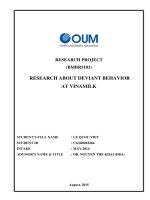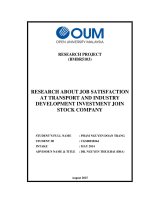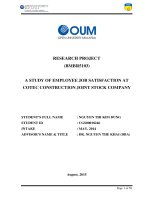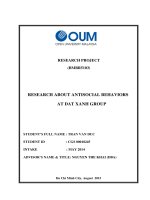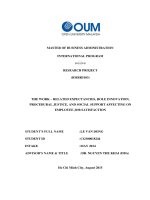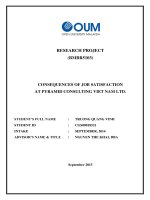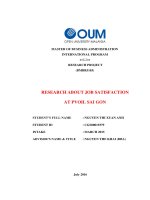Research about job satisfaction at pvoil sai gon
Bạn đang xem bản rút gọn của tài liệu. Xem và tải ngay bản đầy đủ của tài liệu tại đây (1.33 MB, 54 trang )
MASTER OF BUSINESS ADMINISTRATION
INTERNATIONAL PROGRAM
RESEARCH PROJECT
(BMBR5103)
RESEARCH ABOUT JOB SATISFACTION
AT PVOIL SAI GON
STUDENT’S FULL NAME
: NGUYEN THI XUAN ANH
STUDENT ID
: CGS00019379
INTAKE
: MARCH 2015
ADVISOR’S NAME & TITLE
: NGUYEN THE KHAI (DBA)
July 2016
ADVISOR’S ASSESSMENT
..…………………………………………………………………………………………………………
..…………………………………………………………………………………………………………
..…………………………………………………………………………………………………………
..…………………………………………………………………………………………………………
..…………………………………………………………………………………………………………
..…………………………………………………………………………………………………………
..…………………………………………………………………………………………………………
..…………………………………………………………………………………………………………
..…………………………………………………………………………………………………………
..…………………………………………………………………………………………………………
..…………………………………………………………………………………………………………
..…………………………………………………………………………………………………………
..…………………………………………………………………………………………………………
..…………………………………………………………………………………………………………
..…………………………………………………………………………………………………………
..…………………………………………………………………………………………………………
ADVISOR’S SIGNATURE
(FEBRUARY 2016)
NGUYEN THE KHAI (DBA)
ACKNOWLEDGMENTS
After a period of study and research I have completed the topic "Job
satisfaction at PVOIL SAI GON”. During the implementation process , I received
guidance and enthusiastic support from my teachers , friends , relatives . I would
like to deeply thank to:
Teachers from Open University Malaysia imparted to me the background
knowledges of this thesis.
Deeply thanks to my thesis instructor - Dr NGUYEN THE KHAI dedicated
guide me so that i can complete the thesis.
Thanks to my friends, my colleagues from audit firms for enthusiastic help in
the process of collecting data for this thesis.
Thanks to my family, my sisters and brothers, my friends who gave me honest
advices and support me in the process of completing my thesis.
Nguyen Thi Xuan Anh Student
CONTENTS
ABSTRACT ............................................................................................................... 1
PART ONE: INTRODUCTION .............................................................................. 2
General information: ............................................................................................... 2
Company history: .................................................................................................... 2
Position of the Company in the industry: ................................................................ 3
Main business activity: ............................................................................................ 4
ORGANIZATIONAL STRUCTURE AND CORPORATE CULTURE ............... 5
Organizational structure....................................................................................... 5
Products offering: ................................................................................................ 5
Distribution Channels: ......................................................................................... 6
Corporate culture: ................................................................................................ 7
RESEARCH PROBLEM STATEMENT ............................................................... 7
RESEARCH OBJECTIVES .................................................................................... 9
RESEARCH QUESTIONS ..................................................................................... 9
RESEARCH SCOPE ............................................................................................... 9
SIGNIFICANCE OF RESEARCH ....................................................................... 10
LIMITATION OF RESEARCH ........................................................................... 10
PART TWO: LITERATURE REVIEW............................................................... 11
Definition of Constructs ........................................................................................ 11
Job Satisfaction .................................................................................................. 11
Work-Related Expectancies............................................................................... 12
Fairness-Perceptions of an Organizational Policy ............................................. 12
Person-Organization Fit ..................................................................................... 13
Individual Beliefs about Organizational Ethics ................................................. 14
The Relationship between Work-Related Expectancies and Job Satisfaction: . 14
The Relationship between Fairness-Perceptions of an Organizational Policy and
Job Satisfaction: ................................................................................................. 17
The Relationship between Person-Organization Fit and Job Satisfaction: ....... 19
The Relationship between Individual Beliefs about Organizational Ethics and
Job Satisfaction: ................................................................................................. 20
Hypotheses ............................................................................................................ 22
Research model .................................................................................................. 23
PART 3: METHODS .............................................................................................. 24
Data collection ....................................................................................................... 24
Data analysis .......................................................................................................... 30
PART FOUR: RESULTS ......................................................................................... 31
Cronbach’s Alpha .................................................................................................. 31
Cronbach’s Alpha standard applied ................................................................... 31
Cronbach’s Alpha of constructs......................................................................... 31
Statistics information ............................................................................................. 33
Descriptive statistics .......................................................................................... 33
Correlation statistics .......................................................................................... 33
Hypotheses testing ................................................................................................. 35
Hypothesis proposed (H1) ................................................................................. 35
Hypothesis proposed (H2) ................................................................................. 36
Hypothesis proposed (H3) ................................................................................. 37
Hypothesis proposed (H4) ................................................................................. 38
PART FIVE: CONCLUSIONS .............................................................................. 39
Discussion.............................................................................................................. 39
Limitation of research............................................................................................ 39
Forecast recommendation ...................................................................................... 39
REFENRENCES ....................................................................................................... 47
FIGURE & TABLE
FIGURE
Figure 1: Research model of Job Satisfaction ........................................................... 23
TABLE
Table 1: Job Satisfaction Scale ................................................................................. 24
Table 2: Work-Related Expectancies ........................................................................ 25
Table 3: Fairness-Perceptions of an Organizational Policy ...................................... 27
Table 4: Person-Organization Fit .............................................................................. 28
Table 5: Individual Beliefs about Organizational Ethics .......................................... 29
Table 6: Time table for data collection progress....................................................... 30
Table 7: Cronbach’s Alpha - Internal Consistenc).................................................... 31
Table 8: Cronbach’s Alpha of Job Satisfaction ........................................................ 31
Table 9: Cronbach’s Alpha of Work-Related Expectancies ..................................... 32
Table 10: Cronbach’s Alpha of Faieness Perceptions of an Organizational Policy . 32
Table 11: Cronbach’s Alpha of Person-Organization Fit ......................................... 32
Table 12: Cronbach’s Alpha of Individual Beliefs about Organizational Ethics ..... 33
Table 13: Descriptive statistics ................................................................................. 33
Table 14: Correlation statistics.................................................................................. 34
Table 15: Model summary of H1 .............................................................................. 35
Table 16: Coefficients of H1 ..................................................................................... 35
Table 17: Model summary of H2 .............................................................................. 36
Table 18: Coefficients of H2 ..................................................................................... 36
Table 19: Model summary of H3 .............................................................................. 37
Table 20: Coefficients of H3 ..................................................................................... 37
Table 21: Model summary of H4 .............................................................................. 38
Table 22: Coefficients of H4 ..................................................................................... 38
Business Research Methods
P a g e 1 /48
ABSTRACT
The purpose of this research is to determine the relationship between variables in the
model such as Work-Related Expectancies, Fairness Perceptions of an Organizaional
Policy, Person-Organization Fit Scale and Individual Beliefs about Organizational
Ethics with Overall Job Satisfaction. The research result was conducted in PVOIL
SAI GON JSC with 253 employees.
And SPSS software version 22 (copyright of IBM) is a tool that is used to analysis
data in this research. The collected data were analyzed through factor analysis,
Cronbach’s alpha, descriptive statistics, correlation, and multiple regression analysis.
The research showed that there are four factors influencing overall job satisfaction
are Work-Related Expectancies, Fairness Perceptions of an Organizaional Policy,
Person-Organization Fit Scale and Individual Beliefs about Organizational Ethics.
Moreover, the research provides some recommendations implications for managers
to raise the level of satisfaction with work of the employees.
Key word: Work-Related Expectancies, Fairness Perceptions of an Organizaional
Policy, Person-Organization Fit Scale and Individual Beliefs about Organizational
Ethics.
Student: Nguyen Thi Xuan Anh (ID: 19379)
Business Research Methods
P a g e 2 /48
PART ONE: INTRODUCTION
About PVOIL SAI GON
General information:
Name of Company: CÔNG TY CỔ PHẦN XĂNG DẦU DẦU KHÍ SÀI GÒN
Name in English: Saigon PetroVietnam Oil Join Stock Company
Abbreviated name: PV OIL Saigon
Headquarter: the 10th Floor, Petroland Tower, 12 Tan Trao Street, Tan Phu
Ward, District 7, Ho Chi Minh City, Vietnam
Company history:
2007 - 2010: Sài Gòn Oil and Gas Petroleum Enterprise, founded in July 2008, was
an accounting unit of PetroVietnam Oil Corporation, the establishement was in the
development and completion strategies of the early phases of the PetroVietnam Oil
Corporation, with the aim of completing and developing comprehensively the oil and
gas industry from searching, exploiting, exploring phases and oil refinery, processing
petroleum products to distributing products.
The PetroVietnam Oil Corporation’s responsibility was to purchase and distribute
petroleum and petroleum products to customers in the Ho Chi Minh City as well as
neighboring provinces and South-western region.
Student: Nguyen Thi Xuan Anh (ID: 19379)
Business Research Methods
P a g e 3 /48
2010 - present: Sài Gòn Oil and Gas Petroleum Joint Stock Company (PV OIL Saigon
for short) was born on December 04, 2010, on the basis of restructuring the
organization and operation of the Sài Gòn Oil and Gas Petroleum Enterprise. PV OIL
Saigon has inherited the entire infrastructure, leaders and employees, system of
distribution channels and customers from Sài Gòn Oil and Gas Petroleum Enterprise.
PV OIL Saigon, a Joint Stock Company hold 65.18% of charter capital by the
PetroVietnam Oil Corporation’s, is the focal point unit of petroleum and petroleum
products. When joining the oil and gas market, PV OIL Saigon has taken advantage
of opportunities, promoted strength as a member unit of the PetroVietnam Oil
Corporation and affirmed its position in Ho Chi Minh city and South-western
provinces.
Position of the Company in the industry:
PV OIL Saigon is a focal point unit providing petroleum and petroleum products for
the whole distribution and customer systems of the downstream distribution system
of the PetroVietnam Oil Corporation (PV Oil). The customers include general
agencies, agencis, industrial customers and household consumption, customers
temporarily importing and re-exporting to export processing zones, etc.
Business location of the company includes HCM City, neighboring provinces and
Southwest area. The location has a higher growth rate when compared to other
regions in the whole country, which concentrates a range of receiving port
warehouses and focal point units providing petroleum products of large enterprises
such as PetroVietnam Oil Corporation, Petec Trading & Investment Corporation
(Petec), The Ho Chi Minh City One-Member Limited Liability Oil & Gas (Saigon
Petro), Petroleum Company Zone 2 (Petrolimex Saigon), Dong Thap Petroleum
Trading Import Export Company Limited (Petimex), Military Petroleum
Corporation (Mipeco), Military Petrochemical Joint Stock Company (Mipec), etc.
Student: Nguyen Thi Xuan Anh (ID: 19379)
Business Research Methods
P a g e 4 /48
The petroleum market in the area is quite fierce with the competition of many
enterprises, esspecially the oil retail market is always exciting with the participation
of private enterprises, because it does not require large investment and scale and
complicated technical requirement.
Main business activity:
PV OIL Saigon is in the field of trading in fuel oil and providing related support
services, with the main business line as follows:
Selling wholesale the solid, liquid, gas and related products (excluding liquefied
petroleum gas - LPG), temporarily importing and re-exporting oil and gas.
Selling retail the engine fuel for specialized stores, including fuel for cars,
motorcycles, and other motor vehicles;
Selling retail lubricant and engine cooling products for cars, motorcycles, and other
motor vehicles.
Producing refined petroleum products (not produced at the office).
Operating warehousing and storaging goods.
Transporting goods by road; pipeline; inland waterway; Coastal and ocean freight.
Other support services related to transportation.
Student: Nguyen Thi Xuan Anh (ID: 19379)
Business Research Methods
P a g e 5 /48
ORGANIZATIONAL STRUCTURE AND CORPORATE CULTURE
Organizational structure
The organizational structure of the Company is presented in the diagram below:
GENERAL
SHAREHOLDER
MEETING
INSPECTION
COMMITTEE
BOARD OF
DIRECTOR
GENERAL
DIRECTOR
OFFIC
E OF
ORGAN
IZATIO
N – AD
MINIST
RATIO
N
OFFICE OF
FINANCE
AND
ACCOUNTIN
G
OFFICE OF
PLANNING
- INVEST
MENT
OFFICE
OF
TRADING
PETROLE
UM
OFFICE
OF
GENER
AL
BUSINE
SS
CAN THO
OIL AND
GAS
ENTERPR
ISE
BRANCH
ES IN
PROVINC
ES
MARKETI
NG TEAM
INDUSTR
IAL
SALES
TEAM
OFFICE
OF
ORGANI
ZATION
PETROL
STATIO
NS
SALES
TEAMS
REEXPOR
T SALES
TEAM
OFFICE OF
FINANCE
AND
ACCOUNTI
NG
SALES
TEAMS
OFFICE
OF
SALES
Products offering:
Outline of petroleum products:
Gasoline is one of the products produced from petroleum. In the market, there are
now some types of major petrol such as A83, A92, A95 petrol, E5 bio-petrol (A92-
Student: Nguyen Thi Xuan Anh (ID: 19379)
Business Research Methods
P a g e 6 /48
RON petrol containing 5 per cent ethanol), which are classified based on octane
rating (02 last numbers in the name of each type indicating its octane rating). The
higher octane rating is, the better quality is. Each type of engine is suitable for 01 or
a certain number of gasoline. Gasoline is used to run internal combustion engines,
such as cars, motorcycles, airplane, or other industrial machines, etc.
In addition to gasoline, oil also has a series of types such as DO (diezen oil), KO
(kesonel oil) and FO (fuel oil). DO is to run engines with large capacity, low speed
or industrial machines. Viscosity of KO is lower than that of DO, which is used as
fuel or solvent for industries. FO is black, thick with high viscosity and used as fuel
for engines with lower technical requirements,…
Products and services offering:
The PV OIL Saigon is now providing products such as: A83, A92, A95 petrol and E5
biofuel; types of oil: DO, FO, KO, etc. with different standard content according to
customers' requirement.
Besides, PVOIL Saigon provides customers and partners with services such as
transportation services of petroleum and goods by inland waterway and road. Coastal
and ocean freight, pipeline transport, warehousing and yard rental, etc.
Distribution Channels:
PV OIL Saigon, with the role of the downstream distribution of PV OIL, holds most
of the customers of PV OIL in HCM City as well as neighboring provinces and
South-western provinces. Depending on the scale consumption and organizational
capacity of production and business as well as conditions prescribed by the State, PV
OIL Saigon has classified customers into groups: distributors, franchisors (formerly
Student: Nguyen Thi Xuan Anh (ID: 19379)
Business Research Methods
P a g e 7 /48
known as General agencies, Agencis), directly consuming households, industrial
customers, customers temporarily importing and re-exporting, etc.
The distribution channel system of PV OIL Saigon has also been divided into: retail
distribution channels, retail distribution channels through Agencis, General agencies,
wholesale distribution channels (wholesale), temporary import and re-export.
Until now, the total number of customers through the distribution channels of PV OIL
Saigon has included 23 distributors, about 500 franchisors, 85 agencies directly
consuming, 40 industrial customers and 07 customers temporarily importing and reexporting.
Corporate culture:
Professionalism & Efficiency.
Openness & Honesty.
Loyalty & Dedication.
Collaboration & Sharing.
Company‘s development together with individual’s success.
RESEARCH PROBLEM STATEMENT
PV OIL Saigon is a focal point unit providing petroleum and petroleum products for
the whole distribution and customer systems of the downstream distribution system
of the PetroVietnam Oil Corporation (PV Oil). The customers include general
agencies, agencis, industrial customers and household consumption, customers
temporarily importing and re-exporting to export processing zones, etc.
Business location of the company includes HCM City, neighboring provinces and
Southwest area. The location has a higher growth rate when compared to other
Student: Nguyen Thi Xuan Anh (ID: 19379)
Business Research Methods
P a g e 8 /48
regions in the whole country, which concentrates a range of receiving port
warehouses and focal point units providing petroleum products of large enterprises
such as PetroVietnam Oil Corporation, Petec Trading & Investment Corporation
(Petec), The Ho Chi Minh City One-Member Limited Liability Oil & Gas (Saigon
Petro), Petroleum Company Zone 2 (Petrolimex Saigon), Dong Thap Petroleum
Trading Import Export Company Limited (Petimex), Military Petroleum
Corporation (Mipeco), Military Petrochemical Joint Stock Company (Mipec), etc.
The petroleum market in the area is quite fierce with the competition of many
enterprises, esspecially the oil retail market is always exciting with the participation
of private enterprises, because it does not require large investment and scale and
complicated technical requirement.
Currently, in the context of The petroleum market at Vietnam is very tough and
working environment of The petroleum market Vietnam has too many changes but
not yet have any researches finding about job satisfaction of employees at these
companies.
PVOIL SAI GON is aggressively developing and growing human resource,
especially in the selection of right people for the company. However, recruiting right
people is not enough and they are embarrassing to know how to keep talent
employees, retain talents, especially how to retain their key staff who plays a key role
in the company. With the shortage of human capital as today, retention good people
are becoming big issue of PVOIL SAI GON.
Director at PVOIL SAI GON realized Job Satisfaction of employees is important
factor for Vingroup develop sustainably their human resource to help organization to
operate more efficient, produce quality of products and services, build brand
awareness, customer trust and loyalty… But, some factors such as Work-Related
Expectancies, Fairness Perceptions of an Organizaional Policy, Person-Organization
Fit Scale and Individual Beliefs about Organizational Ethics are problems for human
resource management at PVOIL SAI GON.
Student: Nguyen Thi Xuan Anh (ID: 19379)
Business Research Methods
P a g e 9 /48
RESEARCH OBJECTIVES
This purpose of this research is way to find the factors influence to the Job
Satisfaction of employees working at PVOIL SAI GON.
My research will focus 3 main factors:
Firstly: search related information and try to define what meaning Job Satisfaction is
of employees at PVOIL SAI GON.
Secondly: design research model and test related factors to check influence between
factors to access strong / weak level of each factor in influence progress.
Thirdly: discussing and proposing recommendation to improve the effectiveness and
forecast the human resources management at PVOIL SAI GON in the next time.
RESEARCH QUESTIONS
This research mentions the following points:
How are the impacts of Work-Related Expectancies on PVOIL SAI GON employee
Job Satisfaction?
How are the impacts of Fairness Perceptions of an Organizational Policy on PVOIL
SAI GON employee Job Satisfaction?
How are the impacts of Person-Organization Fit Scale on PVOIL SAI GON employee
Job Satisfaction?
How are the impacts of Individual Beliefs about Organizational Ethics on PVOIL
SAI GON employee Job Satisfaction?
RESEARCH SCOPE
The scope of this research is for the entire employees at PVOIL SAI GON (253
employees), includes: General Director, Vice General Directors, managers, and
employees working at PVOIL SAI GON; it does not include: Board of Directors,
Student: Nguyen Thi Xuan Anh (ID: 19379)
Business Research Methods
P a g e 10 /48
Shareholder, Supervisory Board, and employees are under probation period or in
maturity leave.
The survey scope is within the territory of Vietnam, which includes 253 employees
of PVOIL SAI GON Company.
Contents of this research are only including factors influencing to Job Satisfaction at
PVOIL SAI GON; it does not have intention of re-structuring, changing and replacing
the employees.
This survey was conducted from 1 Jan to 25 Jan 2016.
SIGNIFICANCE OF RESEARCH
This research will help Directors; managers understand and are more aware of the
importance of Job Satisfaction. That is the most important factor to show the
effectiveness of the policy, the organization operating concept in human matters.
Besides, PVOIL SAI GON should have a strategies and policies to improve the
satisfaction of employees in the company, so they commit to loyalty to the company
for a long time.
LIMITATION OF RESEARCH
This research will have some limitations because it only focuses on the related content
(oil and fuel) at PVOIL SAI GON.
The survey conducted in slightly short time.
This survey was conducted on a small scale, such as subsidiaries, was not conducted
Vietnam Oil and Gas Group scale.
Student: Nguyen Thi Xuan Anh (ID: 19379)
Business Research Methods
P a g e 11 /48
PART TWO: LITERATURE REVIEW
Definition of Constructs
Job Satisfaction
It was developed by Cammann, Fichman, Jenkins, and Klesh (1983) as part of the
Michigan Organization assessment questionnaire. It includes 3 items.
The concept of job satisfaction has been developed in many ways by many different
researchs and practitioners. One of the most widely used definitions in organizational
research is that of Weiss (2002), who defines job satisfaction as “Job satisfaction has
been defined as a pleasurable emotional state resulting from the appraisal of one’s
job; an affective reaction to one’s job; and an attitude towards one’s job.”. Weiss
(2002) has argued that job satisfaction is an attitude but points out that researchers
should clearly distinguish the objects of cognitive evaluation which are affect
(emotion), beliefs and behaviours. This definition suggests that we form attitudes
towards our jobs by taking into account our feelings, our beliefs, and our behaviors.
Job satisfaction is the level of contentment a person feels regarding his or her job.
This feeling is mainly based on an individual's perception of satisfaction. Job
satisfaction can be influenced by a person's ability to complete required tasks, the
level of communication in an organization, and the way management treats
employees.
Job satisfaction falls into two levels: affective job satisfaction and cognitive job
satisfaction. Affective job satisfaction is a person's emotional feeling about the job as
a whole. Cognitive job satisfaction is how satisfied employees feel concerning some
aspect of their job, such as pay, hours, or benefits.
Student: Nguyen Thi Xuan Anh (ID: 19379)
Business Research Methods
P a g e 12 /48
Work-Related Expectancies
It was developed by Eisenberger, Fassolo, and Davis-LaMastro (1990) to describe
the extent to which employees believe that higher levels of job performance will be
rewarded. It includes 6 items.
The measure assesses employee expectancies about the relationship of better
performance with increased pay, promotions and job security.
It also assesses employee expectancies that better performance will lead to increased
influence, supervisory approval, and recognition.
Fairness-Perceptions of an Organizational Policy
It was developed by Grover (1991), is an example of a measure of fairness directed
to a specific policy area .It includes 9 items.
The perceived fairness of process is as significant as outcomes when engaging
employees, stakeholders or the public.
Human beings are sensitive to the fairness of decisions made or treatment given in
virtually every domain of life. Many situations in organisational life provide
opportunities to evaluate and experience fairness, and these assessments influence the
perceptions of and reactions to these situations.
Fairness perception of an Organizational Policy is a central concept in organisational
psychology, has been shown in research to be important in contexts as diverse as
personnel selection and staffing, performance appraisal, compensation and benefits,
resource allocation, conflict resolution, layoffs, and other human resource functions.
Fairness perceptions also play important roles in public policy implementation and
public engagement efforts, as well as employee engagement and organisational
development efforts relating to issues of attitudes, and behaviour.
While the vast majority of managers and leaders want to be fair and believe that they
are, it is nevertheless not uncommon that employees or members of public often think
Student: Nguyen Thi Xuan Anh (ID: 19379)
Business Research Methods
P a g e 13 /48
and feel that they have not been treated fairly. Given the importance of the value of
fairness and the potential consequences that perceptions of fairness have on employee
or public reactions, it is important that we develop a better appreciation of fairness
perception and its practical implications.
Person-Organization Fit
It was developed by Bretz and Judge (1994). It includes 7 items.
It is defined as the degree of congruence between the organization and the person.
Researchers have suggested that person and organization fit is the key to maintain
committed and flexible workforce which is very important in this competitive world.
It is a situation where an employee has found a job that suits his requirements and
needs, receives enough salary as compare to his/her competitors and has a pleasant
boss. This leads to positive outcomes. On the other side, if the employee does his/her
work with dedication but the organization doesn’t foster the same, this makes the
employee unhappy; thereby decline in performance and finally exiting the
organization.
Example: An employee of XYZ ltd. has high productivity and enjoys working in
teams because he likes the work that he is doing and is committed to deliver to the
organization, this attitude leads him to be a good performer.
Importance of Person Organization Fit:
•
Turnover: It is very obvious that employees don’t like working with
organizations that don’t align with their personal values and goals. Determining the
same during the selection process, helps to reduce the turnover rate.
•
Job Performance: If an employee doesn’t like the work or the environment,
he/she is working in; this has negative effects on the job performance of the
employees.
Student: Nguyen Thi Xuan Anh (ID: 19379)
Business Research Methods
•
P a g e 14 /48
Work Attitudes: The congruence between the work attitude and the person
organization fit is the strongest. The more an individual fits into the organization, the
more positive will be the work attitude.
Person Organization Fit dimensions:
While hiring an employee the following dimensions are looked upon by the
employer during the selection process.
• Easygoing and Aggressive
• Innovative
• Attention to details
• Stable
• Attitude towards people
• Team player
• Attitude towards outcomes
Individual Beliefs about Organizational Ethics
This measure, developed by Froelich and Kottke (1991). It includes 7 items.
Organizational ethics are the standards that address human behavior, promoted and
adhered to by organizations and businesses. The standards attempt to quantify and
regulate human relationships in an effort to avoid harmful behavior or damage to the
organization. Defining and managing the values of a collective group of people within
an organization composes the practical application of organizational ethics.
The Relationship between Work-Related Expectancies and Job Satisfaction:
Unlike Maslow, Vroom does not concentrate on needs, but rather focuses on
outcomes. Whereas Maslow looks at the relationship between internal needs and the
Student: Nguyen Thi Xuan Anh (ID: 19379)
Business Research Methods
P a g e 15 /48
resulting effort expended to fulfil them, Vroom separates effort (which arises from
motivation), performance, and outcomes. He realizes that an employee’s performance
is based on individuals’ factors such as personality, skills, knowledge, experience and
abilities. Vroom’s Expectancy Theory assumes that behaviour results from conscious
choices among alternatives whose purpose it is to maximize pleasure and minimize
pain. The relationship between people’s behaviour at work and their goals is not as
simple as was first imagined by other scientists. Vroom’s theory is based upon the
following three beliefs: valence, expectancy and instrumentality
1. Valence.
Valence refers to the emotional orientations people hold with respect to outcomes
(rewards). The depth of the want of an employee for extrinsic (money, promotion,
time-off, benefits) or intrinsic (satisfaction) rewards. Management must discover
what employees’ value.
2. Expectancy.
Employees have different expectations and levels of confidence about what
they are capable of doing. Management must discover what resources,
training, or supervision employees need.
3. Instrumentality.
The perception of employees whether they will actually get what they
desire even if it has been promised by a manager. Management must ensure that
promises of re-wards are fulfilled and that employees are aware of that. The
expectancy theory says that individuals have different sets of goals and can be
motivated if they believe that:
– There is a positive correlation between efforts and performance,
– Favourable performance will result in a desirable reward,
Student: Nguyen Thi Xuan Anh (ID: 19379)
Business Research Methods
P a g e 16 /48
– The reward will satisfy an important need,
– The desire to satisfy the need is strong enough to make the effort worthwhile.
Unmet expectations have been found to be associated with lower levels of
identification with the organization and job involvement (Ashforth, Saks 2000),
higher levels of voluntary turnover (Buckley et al. 1998; Lance et al. 2000), low job
satisfaction (Nelson, Sutton 1991; Turnley, Feldman 2000; Wanous et al.1992),
higher levels of distress (Nelson, Sut-ton 1991), lower commitment (Wanous et al.
1992), and lower levels of interpersonal trust (Robinson 1996; Young, Perrewe
2000). In the context of work socialization and adjustment, unmet expectations have
been found to predict averse scores on work adjustment (Feij et al. 1995), even more
strongly than personal dispositions such as general selfefficacy and negative
affectivity (Saks, Ashforth 2000). The degree to which individuals feel that their
expectations are met may be construed to reflect their evaluation of the outcome of
their exchange relationship with the organization, emphasizing the powerful role
possessed by individual psychological contracts (i.e., how well did\ the organization
fulfil one’s pre-entry expectancies, Dabos, Rousseau 2004; Lance et al. 2000). Based
on their re-entry expectations regarding the outcomes of this exchange relationship,
newcomers consciously or unconsciously decide how much they will ‘‘invest’’ in this
relationship (e.g., in terms of time, skill, effort, motivation). If this relationship does
not reap the anticipated returns (e.g., in terms of job security, variety, satisfaction,
opportunities for further development, recognition from others), the exchange with
the organization is inequitable (Adams 1965), possibly leading workers to reduce
their investments in this exchange relationship to make it more equitable (Taris et al.
2004). The greater the difference between expectations and experiences, the larger
the gap to which an individual must respond, and the more likely it is that an
individual will take action to reduce or remove this gap, especially when ex-perience
does not live up to one’s initial expectations (i.e., things are worse than expected). In
this sense, unmet expectations may be considered a stressor that individuals must
cope with (Taris et al. 2006).
Student: Nguyen Thi Xuan Anh (ID: 19379)
Business Research Methods
P a g e 17 /48
The Relationship between Fairness-Perceptions of an Organizational Policy and
Job Satisfaction:
Organizational justice is concerned with perceptions of fairness in the workplace.
This line of research examines how and why employees make judgments of fairness
and how these determinations impact work-related behaviors and attitudes. Previous
research has found that employees are more likely to demonstrate positive work
attitudes and behaviors when they perceive the organization and authority figures as
fair (Cohen-Charash & Spector, 2001; Colquitt, Conlon, Wesson, Porter, & Ng,
2001). Conversely, when employees feel they have not been treated fairly in workrelated matters, they are more likely to respond with anger, resentment and retaliatory
behaviors (Nabatchi, Bingham, & Good, 2007; Priesemuth, Arnaud, & Schminke,
2013). Given the importance of fairness in the work environment, there has been vast
discussion regarding the dimensionality of organizational justice over the last 50
years. Initially viewed as a unidimensional construct (Adams, 1965), scholars have
since recognized that organizational justice is comprised of multiple dimensions that
individually, as well as collectively, impact perceptions of fairness (Cohen-Charash
& Spector, 2001; Colquitt, 2001). Extant research supports the position of Greenberg
(1993), who proposed a four dimension model of organizational justice which
includes distributive justice, procedural justice, and two factors of interactional
justice: interpersonal justice and informational justice (Colquitt, 2001; Colquitt et al.,
2001; Crawshaw, Cropanzano, Bell, & Nadisic, 2013; Goldman et al., 2007).
Research on the dimensionality of organizational justice has shown that these four
factors are empirically distinct and therefore should be differentiated from one
another (Colquitt, 2001).
Distributive justice is determined by the perceived fairness of outcomes experienced
by an employee. Adams (1965) found that employees were more likely to view
organizational outcomes as fair when they were consistent with expectations based
on perceived effort or ‘‘inputs’’. Procedural justice is based on judgments of fairness
regarding the policies and procedures used in the decision making process of
Student: Nguyen Thi Xuan Anh (ID: 19379)
Business Research Methods
P a g e 18 /48
organizations (Ambrose, 2002; Cropanzano & Schminke, 2001). Initial research on
this construct was conducted by Thibault and Walker (1975) who explored litigant
perceptions of fairness with the legal process. Their work, specifically the importance
of process influence and control, was first applied to an organizational setting by
Leventhal (1980). This author expanded the work of Thibault and Walker (1975) and
introduced other determinants of procedural justice in addition to process influence
and control.
As research on organizational justice continued, Bies and Moag (1986) introduced
the notion of interactional justice as a component of organizational justice. These
authors defined interactional justice as the ‘‘quality of interpersonal treatment
received during the enactment of organizational procedures’’ (p. 43). This aspect of
justice is grounded in the perceived fairness an employee experiences related to the
interactions with the organization, specifically those interactions that are not
predicated on established policy or procedure. Subsequent research identified two
subcategories of interactional justice, namely informational and interpersonal justice
(Folger & Cropanzano, 1998; Greenberg, 1990, 1993). While related, these two
subcategories have been shown to be distinct and there is empirical support that each
has differential effects on justice perceptions (Colquitt, 2001).
Interpersonal justice indicates the degree to which employees are treated with respect,
dignity, and courtesy by decision makers within an organization. The presence of
interpersonal justice can alter employee reactions to unfavorable outcomes provided
the employee is treated with consideration (Greenberg, 1993). In a group setting, the
presence of interpersonal justice would mean that group members are treated with
respect and courtesy regardless of their position on issues being considered by the
group. Informational justice is based on the degree of explanation provided to
employees regarding distribution of outcomes and the procedures used to make these
determinations (Colquitt, 2001; Greenberg, 1993). Explanations provide the
information necessary to evaluate the structural elements of the processes used to
Student: Nguyen Thi Xuan Anh (ID: 19379)
Business Research Methods
P a g e 19 /48
make the decision and relative fairness of the outcomes (Nabatchi et al., 2007).
Information provided to personnel regarding decisions may be particularly relevant
in the sport setting where a number of stakeholders are involved in the decision
making process (Chelladurai, 2006).
The Relationship between Person-Organization Fit and Job Satisfaction:
Perceived Person-Organization Fit (Value Congruence) and Positive Work
Outcomes. Previous studies in various work environments have suggested that P-O
fit is related to a number of positive outcomes for individuals at work, including task
performance and job satisfaction. Bretz and Judge (1994) report that in a sample of
industrial relations employees, individuals who report a higher degree of value
congruence were more likely to have achieved higher positions within their
companies and higher levels of compensation. These workers were shown to have
higher levels of commitment, perform better, and were more effective workers than
others who did not report similar levels of value congruence (Kristof-Brown & Guay,
2011; Kristof-Brown, Zimmerman, & Johnson, 2005). Lauver and Kristof-Brown
(2001) also report positive work outcomes related to P-O fit. Workers in their study
who report a higher degree of value congruence with the organization were more
likely to make contributions to the work day that were above and beyond their
expected work activities. Taken together, these studies suggest that perceived P-O fit,
particularly in terms of value congruence, tends to be positively associated with
individual work performance.
Person-organization fit is related to higher job satisfaction in other work contexts as
well (Greguras & Diefendorff, 2009). In samples including nurses, however, the
relationships of value congruence with job satisfaction and performance have rarely
been examined. Instead, the few researchers who have examined this dimension of
P-O fit with nurses have tended to focus on burnout, turnover intention, or accident
propensity (e.g., Bao et al., 2013). To our knowledge, only three studies have
addressed the relationship between value congruence and job satisfaction with this
Student: Nguyen Thi Xuan Anh (ID: 19379)

